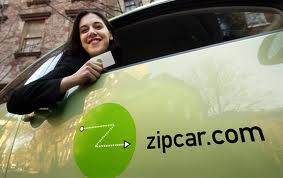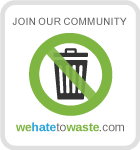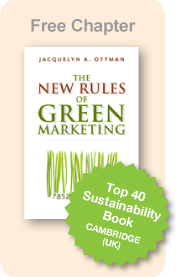Jacquie Ottman's
Green Marketing Blog
Eight Ways to Prevent Household Waste for Fun and Profit
March 05, 2013 by Jacquelyn Ottman

Ask a roomful of consumers, “Who here hates to see things go to waste?” and every hand will likely shoot up. But, if everyone hates to waste, then how come we generate so much of it? And what can we do to prevent waste from being created in the first place? Answering these questions can be profitable and fun.
Turn Waste into Business Opportunity
Despite all the attention paid to them during the past two decades, facilities to recycle and compost are not available in all communities nor are there adequate resources for getting most things repaired. Finally, a lot of food, energy and water are consumed in the privacy of one’s home, so there’s little social stigma about wasting such resources, as long as you have the money to pay.
With zero-waste being the goal, there’s lots of opportunity for future-looking businesses to profit by helping consumers save money, time, space, and better their lives by scraping less food waste into the trash, cutting down on watts, printing double-sided, or using water more sparingly.
Similar to its counterpart, factory-oriented “pollution prevention,” household waste prevention can lead to exciting new products while creating happier and more loyal consumers, and generating lots of free publicity (For the latter, just ask Patagonia about the reaction to their sensation-causing Black Friday ad, “Don’t Buy this Jacket”).
Learning from WeHatetoWaste.com
Our new consumer blog and website, WeHatetoWaste.com spotlights inventive ways that ardent waste-haters have devised to get the last swipe from their deodorant, cut down on paper towels, and create delicious new meals from leftovers. We’re tracking such behaviors in eight categories. Here they are in the hope that they will trigger some ideas for your own business.
Eight Areas of Opportunity
1. DURABLE, NOT DISPOSABLE. The first and most important part of the “reduce, reuse, recycling” triad, ‘reducing’ has become closely associated with ‘making do’ and not buying what you don’t need. But it is also very much about buying quality not quantity, —in sum, durable things that will last.
It’s also about heirloom products that evoke sentimental value—“stories”. Likely crafted from high quality materials, they’re the products that everyone wants to keep forever—- the family silver, Rolex watches, Montblanc pens, even Le Creuset pots and pans and Lego toys.
2. USE IT UP. Especially in tough times (and who knows when they’ll be over?), today’s consumers are looking to use every consumable product right down to its last drop or morsel. They are squeezing that tube of Crest, slicing the Clinique skin cream tube in half, and turning the Palmolive bottle upside down to get those last languorous drops down to the cap where they can be easily accessed.
Check out this WSJ article on this newly-detected consumer behavior to see if you identify your consumers, and come up with ways to help them use your products to the max.
3. FIX IT UP. This is about repairing, refiling, and upgrading so products (and their embodied energy and materials) are not thrown away or even recycled before their time. Getting too many calls from consumers refusing to have to throw away products for lack of an accessible repair center? Fix-It Collectives are sprouting up around the country. How repairable is your product? It’s also about expressing one’s creativity through repurposing and upcycling, suddenly the rave among crafty consumers.
4. SHARE. Also known as ‘collaborative consumption’, the rise of social media is sparking a major trend in peer-to-peer lending, leasing, swapping and renting, as well as selling directly to others on ebay.com and Craigslist.org. Consider the phenomenon that is Zipcar (recently purchased by Avis), Airbnb.com, and Carpooling.com (now in 45 countries).
Design for obsolescence is on track to be obsolete! Power-tool lending libraries are turning the design paradigm upside down: for instance, instead of designing power drills to last their typical six-hour lifespan (e.g., the average time one consumer will use it - no kidding!), they now should be designed to fit the needs of multiple ones.
5. RESPECT FOOD. With 40% of all food that’s farmed in America going to waste before it gets to the table, this is about preserving, conserving, and storing food. It suggests opportunities to help consumers to high quality/low resource storage techniques such as Debbie Meyer “GreenBags” re-usable produce storage bags, and for lightweight, collapsible doggie bags in which diners can take home the second half of their fries and burger.
6. SAVE WATTS AND DROPS. Is Tom’s of Maine toothpaste really ‘green’ if consumers don’t turn off the tap when they brush? Are Energy Star-rated light bulbs really energy-efficient when burning in an empty room?
Opportunities abound for new products that can help consumers minimize the use of resources consumed while owning products e.g., water, energy, materials, and other resources like paper, ink, and toner. To get a gauge on this opportunity, think about the water-saving, energy-saving gadgets you’ve brought recently, and refer to this article about what I call “responsible consumption.”
7. LIVE SMALL AND SMART. This is about living smaller, and also nearer to work, shopping, and other daily activities to eliminate carbon-counting and time-wasting transportation.
Living in a home with just enough space for one’s family and possessions helps cut down on energy needed for heat and air conditioning—and opens up opportunities for double duty furniture (like the kind Graham Hill uses in his LifeEdited.com apartment) and all the space-saving closet and home office furnishings on display at the Container Store.
Want to know more? Check out the “Tiny Apartment” exhibit showcasing the homes for the slew of new NYC residents expected in years to come.
8. RECYCLE AND COMPOST. Representing the last step in the ‘3R’s’ triad, when a product can no longer be used for its primary or even upcycled purpose, it should be recycled or composted in order to sidestep the landfill.
Thanks to recycling and composting, San Francisco now diverts a record 80% of all waste generated from landfills, making it the Greenest City in America, and creating the potential for ten times more jobs and new compostable products and packages than landfilling would bring.
Jacquie Ottman is an expert advisor on green marketing and eco-innovation to corporate sustainability leaders and US government eco-labeling programs. A waste-hater since age four, she recently launched WeHatetoWaste.com, a consumer initiative of her firm, the New York City-based, J. Ottman Consulting. She is the author of the highly acclaimed, The New Rules of Green Marketing: Strategies, Tools and Inspiration for Sustainable Branding (Berrett-Koehler, 2011). It was named by Cambridge University (UK) as a top 40 sustainability book.
Recent Posts
Introducing WeHatetoWaste.com
DeMystifying Biobased Products Keys to Marketing Success
Upshot of FTC Revised Green Guides: Let’s Stop Calling Green Products “Green”
Subscribe to Jacquie Ottman’s Green Marketing Blog by clicking here.



 ShareThis
ShareThis

